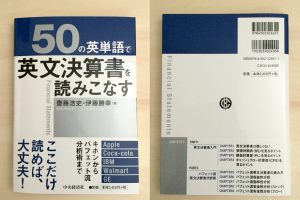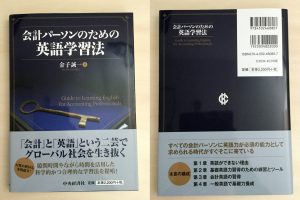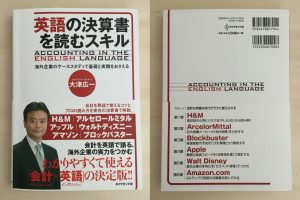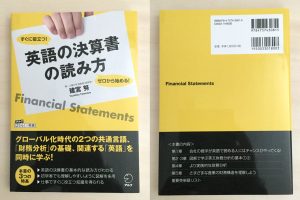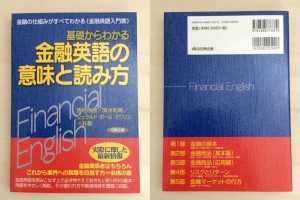超のベストセラー 『財務3表一体理解法』著者最新刊!
ビジネスに必要な 「決算書の知識」と「英語力」が 同時に身につく画期的な本! 会計の仕組みもビジネス英語もこれ1冊でオッケーです。会計の知識だけでなく同時に英語力も身に付き、会計の知識がゼロでも財務3表について理解することができる内容です。
本書は、損益計算書、貸借対照表、キャッシュフロー計算書の基本的な内容を解説し、さらに英語の文も掲載して、会計の知識と英語力を同時に身につけることを目標としている本です。財務諸表の基本から会計の仕組みまで基本的なことから解説しており、会計に詳しくない方も読めるようにしています。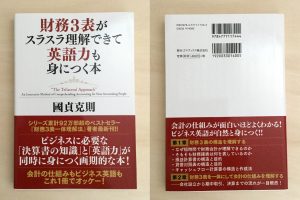
序文
ビジネスがグローバル化する現代においては、日本でも英文会計を 理解しなければならない人が増えてきていると思います。私の会計研 修でも、研修が終了してから「会計の素人が英文で会計を理解するた めによい本はありませんか」という質問をよく受けます。本書はそう いった会計の専門家ではない方で、英文会計を基礎から学びたいと 思っておられる方のために書き下ろした本です。
英文会計も基本的な枠組みは日本の会計と同じです。日本でいう損 益計算書(PL)、貸借対照表(BS)、キャッシュフロー計算書(C S)の財務3表が、英文会計では Income
statement、Balance sheet、 Cash flow statement という名前で存在します。
それは考えてみれば当たり前です。そもそも 15世紀にベニスの商 人によって発明され複式簿記会計の仕組みが全世界に広まったので す。ですから、世界中どこに行っても複式簿記会計の基本的な考え方 は同じなのです。
本書は、2014年1月に電子書籍としては世界で、紙の書籍として は米国と日本で同時出版された『The Trilateral Approach: Financial Statements for Non-Accounting People』(ボナ・ヴィータ コーポレー ション、以降は『The Trilateral Approach』)の日英語対訳版です。そもそも『The Trilateral Approach』は、日本で好評いただいた『財 務3表一体理解法』(朝日新書)の考え方を使って、海外の人たちに も会計を理解してもらいたいと思って執筆した本です。したがって、 既に『財務3表一体理解法』をお読みの方は、本書をスラスラと読み進めていただけると思います。
逆に言えば、本書には『財務3表一体理解法』のエッセンスが詰まっています。『財務3表一体理解法』は、8年程前に私が会計研修 で説明していた内容を本にしたものですが、その後8年間の研修実践の中で、私が解説する内容もよりわかり易くなってきていると思います。本書の内容は正に今私が会計研修で説明している内容に近いも のです。そういう意味では、本書を読むことにより私の提案する会計 勉強法の特徴をより効率よくご理解いただけると思います。
さらに言えば、会計は英語で学んだ方がわかり易い面もあります。 例えば、「売掛金」とか「利益剰余金」とかのように言葉の後ろに「金」 という字があると、何かそこに現金があるような錯覚に陥りがちです が、「売掛金」とか「利益剰余金」とかといった現金があるわけでは ありません。「売掛金」は英語では Account receivable と言い、「受け 取る口座」といった意味がある言葉です。Account receivable の方が 「売掛金」の本来の意味をより的確に表わしていると思います。ちな みに「利益剰余金」は Retained earnings と言い、「利益の積み上げ」 といった意味です。こちらも本来の意味合いに近い表現です。また、本書の英文は、私が書いた日本語原稿を米国人の一流翻訳家 が英語に翻訳してくれたものです。本書をお読みいただければ英語の 勉強になると思います。私もそうでしたが、英語の原書を読破すると 自信につながります。
本書をお読みいただければわかりますが、英語が得意でない方でも 間違いなく英文で会計の基本は理解できます。さあ、肩の力を抜いて 英文と会計の世界に入っていってください。
目次
CONTENTS
<Preface>…
Chapter 1 Understanding the Structure of the Three Financial Statements
(1) How Can You Understand Financial Accounting with Minimal Study Time?
(2) What Do Financial Statements Show in the First Place?
(3) The Structure and Purpose of the Income Statement
(4) The Structure and Purpose of the Balance Sheet
<Column> Why Is It Called the “Balance Sheet”?
(5) What We Can See through Illustrating the Balance Sheet
(6) What is Double-entry Bookkeeping?
(7) The Structure of the Cash Flow Statement and Two Preparation Methods
Chapter 2 The Trilateral Method: Comprehending How Accounting Works by Integrally
Understanding the Three Financial Statements
(1) The Five Links among the Three Financial Statements
(2) Founding a Company with Capital of $8 Thousand
(3) Raising Funds by Issuing Corporate Bonds ($10 Thousand)
目次
<序文>
<はじめに >
第1章 財務3表の構造を理解する
(1) なぜ短時間で財務会計 (Financial accounting)が理解できるのか
(2) そもそも財務諸表 (Financial statements) は何を表しているのか
(3) 損益計算書 (Income statement)の構造と目的
(4) 貸借対照表(Balance sheet)の構造と目的
<コラム > なぜバランスシートと言うのか
(5) 貸借対照表(Balance sheet) を図にするといろんなことが見えてくる
(6) 複式簿記 (Double-entry bookkeeping)とは何か
(7) キャッシュフロー計算書 (Cash flow statement) の構造と2つの作成法
第2章 財務3表を一体にして会計の仕組みを理解する
(1) 財務3表の5つの「つながり」
(2) 資本金8千ドルで会社設立
(3) 社債 (10千ドル)を発行してさらにお金を集める
(4) Purchasing Office Supplies (Total $1 Thousand) with Cash
(5) Purchasing a Freezer ($12 Thousand) with Cash
(6) Procuring Japanese Food Materials for $5 Thousand in Cash
(7) Selling Japanese Food Materials for $10 Thousand in Cash
<Column> Recording Purchases as Inventories for Accounting Purposes
(8) Executing Debt Finance through a $20 Thousand Short-term Loan
(9) Procuring Japanese Food Materials of $30 Thousand on Accounts Payable
(10) Selling Japanese Food Materials of $60 Thousand on Accounts Receivable
(11) Paying Accounts Payable of $30 Thousand
<Column> Profit Earned Yet Short on Cash
(12) Collecting a $40 Thousand Portion of Accounts Receivable Totaling $60 Thousand
(13) Paying Salaries of $7 Thousand
(14) Repaying a $20 Thousand Short-term Loan with Interest of $1 Thousand
(15) Recording Inventories of $5 Thousand
(16) Recording Depreciation of $2 Thousand
(17) Recording Taxes of $9 Thousand
(18) Paying Dividends of $4 Thousand
<In Closing>
(4) 事務用品(総額1千ドル)を現金で購入
(5) 冷凍庫 (12 千ドル)を現金で購入
(6) 日本食材を現金5千ドルで仕入れ
(7) 日本食材を現金 10 千ドルで販売
<コラム > 仕入れたときに在庫として計上する会計処理
(8) 短期借入金 20千ドルの借入実行
(9) 日本食材 30千ドルを買掛で仕入れ
(10) 日本食材 60千ドルを売掛で販売
(11) 買掛金 30 千ドルの支払い
<コラム > 勘定合って銭足らず
(12) 売掛金 60 千ドルのうち 40 千ドルを回収
(13) 給料7千ドルの支払い
(14) 短期借入金 20 千ドルの返済と利息1千ドルの支払い
(15) 在庫5千ドルを計上
(16) 減価償却費2千ドルを計上
(17) 税金9千ドルを計上
(18) 配当金4千ドルの支払い
<おわりに>
Preface
This book is a guide to an entirely new way of studying accounting. Unbelievable as it may seem, reading this book will give you a general overview of accounting and an understanding of its basic workings-no prior accounting knowledge is required. You will learn how to analyze a company’s financial condition based on its financial statements.
The study method presented in this book has already proven to be effective in Japan. The book was first published in Japan in 2007 under the title of Trinity Method: Understanding Financial Statements (Asahi Shimbun Publications Inc.). To date, print runs for this title
have reached 440,000 copies. Combined with other publications surrounding this study method, such as comic-book versions, a total of 900,000 copies are already in print.
What makes this new way of studying accounting unique is that readers study the three financial statements-the income statement, the balance sheet and the cash flow statement as an integral whole. Saving the details for the book’s main chapters, let me say here that
this study method will empower readers to understand the workings of accounting without having to first learn double-entry bookkeeping or journal entry.
Just to be clear, you will see the term “the three financial statements” appear frequently in this book. The three financial statements refer to the income statement, the balance sheet, and the cash flow statement.
Although I conceived this study method, I am not an accountant by trade. My background is in engineering. I have never worked as a professional accountant, nor do I have any special accounting qualifications. Like many of you, I struggled for a long time because I
did not understand how accounting really works. However, you will find that the framework of accounting itself is extremely simple once you have understood it.
はじめに
この本で紹介するのは全く新しい会計 (Accounting) の勉強法です。 信じられないかもしれませんが、この本を読めば会計の知識が全くな い方であっても、会計の全体像と基本的な仕組みが理解でき、財務諸表(Financial statements)から会社の状態が分析できるようになり ます。
本書で紹介する勉強法の効果は既に日本で証明済みです。日本では 2007 年に『財務3表一体理解法』(朝日新書)という名前で出版され、 この本は現在までにそれぞれ44 万部が印刷されました。この勉強法 に関連するコミック版などの書籍を合計すると既に 90 万部が印刷されています。
この新しい会計勉強法の特徴は損益計算書(Income statement)と 貸借対照表(Balance sheet)とキャッシュフロー計算書(Cash flow statement) の3つの表を一体にして勉強するというものです。詳細 な説明は本文に譲りますが、この勉強法により簿記(Double-entry bookkeeping)や仕訳 (Journal entry) を勉強しなくても会計の仕組 みが理解できます。
ちなみに、本書では「財務3表」という言葉が頻繁に出てきますが、 「財務3表」とは、損益計算書、貸借対照表、キャッシュフロー計算 書の3つの財務諸表のことを言います。
この勉強法を考案した私自身は会計の専門家ではありません。元々 エンジニアであり、会計分野で仕事をしたこともなければ会計の資格 も持っていません。私も読者のみなさんと同じように、会計の仕組み が理解できなくて長い間苦労しました。しかし、会計の仕組み自体は、 理解してしまえば極めて簡単なものであることがわかります。







